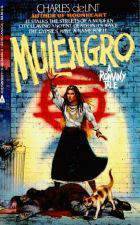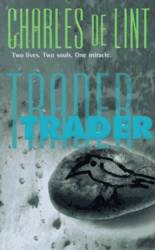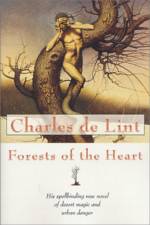

| Charles de Lint has his own home page. | ||
| Click on a book's image or title to order from Amazon.com |

Mulengro: A Romany Tale
Ace, PB, © 1985, 351 pp, ISBN #0-441-54484-3Reviewed June 2000
I read a couple of Charles de Lint's books prior to attending WisCon 24 last month, at which he was guest of honor. As a rule, I am not much of a fan of high fantasy or traditional fantasy elements such as faeries, so when rifling through a friend's collection of de Lint's books, I ended up picking the two which seemed least to have such elements. (It seems most of de Lint's books are modern or "urban" fantasy, which I guess makes him more akin to Tim Powers.)
Mulengro is more properly a horror story than a fantasy tale, in any event: It involves the gypsy communities around Ottawa, Canada, who are being stalked by something superhuman, which seeks to purge the gypsies of those who are marhime, who have strayed too far from the gypsy ways. Most gypsies allow those who are marhime to spend time apart from the community as punishment until they are eventually let back in, but this man - dubbed "Mulengro" for his relationship with dead spirits - believes he's on a mission from God to eliminate them.
Janfri Yayal is a young gypsy who has made money making records of his fiddle playing and whose house is burned down by Mulengro as the story begins. He is informed by an old magic woman that he will play a crucial role in the fight against Mulengro, as will a younger magic woman, Ola, who writes books with an anglo friend of hers about certain lore she knows. Also thrown into the mix are a pair of Ottawa policemen, Ola's friend Jeff and his friend Jackie, Janfri's brother in spirit Yojo, and an unreconstructed sixties hippie named Zach.
As a story, Mulengro is straightforward: The story is largely the gathering of the main characters and the build-up to the showdown with the villain. What makes the book enjoyable is the glimpse into the world of the gypsies: The kinds of things a person or people can accomplish if they aren't tied down by property or by anything else except each other, and the sense of honor and responsibility these people have for each other as a result of this lifestyle. Outsiders, of course, don't perceive much of this, since gypsies' lack of property means that they live in poverty and often beg or steal what they need, believing that doing so is a right given to them by God. Keeping in mind that this is de Lint's interpretation of the culture, it's an interesting one.
Unfortunately, the culture overshadows the story, as Mulengro himself is a cipher at best, and although the other characters are well-drawn, their complexities don't figure much into the resolution of the plot, and except for the fatal incidents, it's hard to see how most of the characters are changed by their experience (the denouement is especially disappointing for some of the supporting characters).
So although its setting is interesting in itself, it's ultimately a story that leaves the reader feeling a bit empty, like there should have been more there in the end.

Trader
Tor, PB, © 1997, 464 pp, ISBN #0-812-55157-5Reviewed June 2000
Trader is a recent take on an old fantasy gimmick (also a favorite of Hollywood): Two people whose minds and souls switch bodies. In this case, luthier (guitar maker) Max Trader, and layabout Johnny Devlin. The book focuses mainly on Max, who is a considerate man who's largely spent his life pursuing his craft, living comfortably, doing what he wants to do. But, save for the past six months when the downstairs neighbor girl Nia has hung around his shop, he's been doing it alone.
One morning he wakes up in Devlin's body, in his grungy apartment, and promptly meets Devlin's girlfriend Tanya, a former model and actress, to whom he owes $300 which he doesn't have. He also meets Tanya's roommate Zeffy, an aspiring guitarist, who loathes Devlin. Max goes to his own apartment where he meets Devlin in his body, who announces his intention to keep and take advantage of his good fortune. Max returns to find he's been evicted from Devlin's apartment due to outstanding debt, and is now homeless.
Trader is a complex story about how people affect each other's lives. Where Devlin was selfish and lazy, Max is industrious and considerate, and although his lack of recognition of Tanya and Zeffy annoys them both and prompts Tanya to break up with him, his general attitude intrigues both of them. Once he's on the street, Max ends up meeting a mysterious indian man in the central park (of the fictional town of Newford in which de Lint sets many of his stories), and finding Max carving exotic wooden figures impels Zeffy to investigate his story about being someone else in Devlin's body.
As a result of all this, Zeffy finds herself attracted to Max, Tanya starts to get on with her life, Nia runs away from home, and her mother is worried sick about her. And Max, well, for all that he's lost in the switch, he starts to think that his old life wasn't quite as pleasant as he'd thought it was, and that this might be the ultimate blessing in disguise.
The first two-thirds of the book primarily examines the nuts and bolts of how Max copes with the switch, and how the other characters react to him, and takes place over just a few days. There's a lot of touching material here, including Max adopting a stray dog named Buddy, and dealing with the complex feelings of responsibility and attraction he feels towards Tanya and Zeffy.
Ultimately the book does head in a more overtly fantastic direction, in which much is explained, and the Max/Devlin situation is hashed out in rather oblique fashion. To my surprise, I was satisfied with both the explanation for why the switch happened, and the resolution of all the characters' plot threads. De Lint's story takes some odd twists and turns which in many other stories would seem at best self-indulgent, but de Lint makes it all look easy, and the last several characters are very moving and effective.
Trader is a long book, but its effectiveness relies on his crisp characterizations, attention to detail, and how all this comes together in the end. It neatly avoids feeling like an updated fable and works effectively as a modern novel.

Forests of the Heart
Tor, TPB, © 2000, 397 pp, ISBN #0-312-87568-1Reviewed October 2001
This is the third Charles de Lint novel I've read. If Mulengro was a novel with some intriguing possibilities which didn't work out because the author was still learning his craft, Trader showed the author in full possession of the skills of a writer, and was an excellent and satisfying novel. Completing the tripod, then, Forests of the Heart perhaps shows a writer too enamored with his skills, and falls flat by being too much sauce and not enough meat.
Like Trader, Forests occurs in the fictional Canadian city of Newford, in the deep of winter. Hunter Cole owns an independent record shop, and Miki Greer is one of his employees. Miki is Irish, and the product of an abusive family. Her brother, the moody and artistic Donal, held their lives together until they were both adults, and following an abortive relationship with fellow artist Ellie Jones, he's moved in with Miki. Ellie works helping the homeless during the winter, with the good-hearted former homeless Tommy, who is a Native American with a collection of enigmatic aunts on the reservation. One night while helping rescue a homeless man, Ellie is approached by a masculine woman named Musgrave Wood, who recruits her to stay at the prestigious house for artists, Kellygnow. Also staying there is the Latina Bettina, who is a mystic healer, called far from her homeland for reasons she cannot fathom.
Ellie, it turns out, is being asked to produce a replica of a mask of great mystical power. Wood is involved with the Gentry, spirits from Ireland who came to America with the departing Irish, but who now have no home of their own, and envy the native manitou spirits and have a plan to make their own place in America. These "Hard Men" will brook no interference from mere mortals, even though they need mortals to complete their design, and all of the characters are drawn into their web and the fantastic forces that are unleashed upon the world in its course.
Simply put, Forests of the Heart has just too darned many characters, and none of them rises to the surface to become a true protagonist. The first half of the book introduces us - in often excruciating detail - to each and every one of them. When Tommy's story is finally told - starting on page 123 - I started to wonder if the story would ever start moving. We're constantly given little hints about the Gentry, their power and attitudes, and Bettina's extensive background and vague purpose. But mostly the first 200 pages are simply characters moving around each other, getting to know each other, and gradually moving to the point when all hell breaks loose.
Unfortunately, it all just takes too long to get to the point. Much of the first half of the book could have been boiled down to considerably fewer scenes and pages. Contrast this with Trader, where the main character is thrown into the deep end of the pool at the onset of the story. It grabs your attention immediately; Forests rarely gives you reason not to go do something else.
Moreover, and perhaps paradoxically, the character who comes closest to being the novel's protagonist - Bettina - is least important to the plot. She and her attendant elements could have easily been edited out without affecting the main story significantly. Ellie, in particular, could have taken her place for the most part. (Ellie and Hunter both remain sketchy characters throughout the book. Ellie is something of a cipher, while Hunter is a stereotype of a divorced man who's lost his way after his wife left him.)
It isn't until after page 250 that the story really kicks into gear, and it does so in a manner disastrous for all the characters, and largely departs from the careful machinations built up through the first chunk of the book, which is in itself weird and makes the first half feel all the more redundant. The challenges of the first half are discarded in favor of a new - albeit greater - threat, which draws the characters together, but the story is basically a simple plot-driven one from there, and ends up feeling only somewhat rewarding, especially as the fates of the characters are largely left open at the story's end.
Essentially, I think de Lint lost sight of the story he was trying to tell, and tried to work in too many characters, too many disparate backgrounds, and too many unusual ideas, and was forced to shunt some of them aside to finally resolve the central conflict, even though that resolution wasn't really a character-driven one. All of this led to a story which plays to his weaknesses as a writer (plotting) rather than his strengths (writing well-drawn characters under intense pressure). And ultimately, it makes for a weak and muddled story.
hits since 13 August 2000.